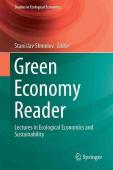
The Green Economy Reader is a collection of thought provoking articles by the leading ecological economics thinkers of our time. State of the art in sustainability thinking, inspired by interdisciplinary ideas of ecological economics, this book is focusing on sustainability pathways, new economic theory, democracy and institutions, multidimensional assessment of sustainability, macroeconomic modelling and policies, climate change and renewable energy, resource flows and circular economy, regenerative cities, environmental conflicts and values. It will be helpful for MSc and PhD students in Economics, Management, Environmental Change, Ecological Economics, Development Economics, Sustainability and practitioners in business, international and nongovernmental organizations, such as UNDP, UNEP, IUCN, OECD. Rich, diverse and thought provoking collection of top level contributions, it will help to facilitate the transition towards sustainability and educational reform.
This paper seeks to better understand how one plausible development in a green energy economy transition of the transport sector can be governed: a breakthrough of battery-electric vehicles (BEV). Drawing on recent results and lessons from BEV studies at local, national and regional scales, the paper presents two alternative scenarios of BEV uptake until 2030 – one incremental growth scenario and one breakthrough scenario. It then draws on the multilevel perspective (MLP) on socio-technical systems as an approach to identify the governance implications of the breakthrough scenario. Based on a characterisation of barriers and drivers at landscape, regime and niche levels, it identifies governance interventions to enable a BEV breakthrough. The results point towards a multidimensional governance approach that includes conventional policy instruments such as durable incentive policies, with a predictable mechanism for adjustment and phase-out, and mechanisms for mobilising investment finance for fast and super-fast charging and home charging along public roads.
The term ‘Green Energy Economy’ (GEE) received increasing policy and scientific attention following the 2008–2009 global financial crisis, leading to the implementation of numerous ‘Green Growth’ economic stimulus packages that targeted low-carbon energy technologies. These initiatives were portrayed as key elements in the transition to a green economy, in which low-carbon energy systems would play a vital role. However, and setting aside conceptual variations, uncertainties and fragmented knowledge remain in the interplay between a green economy, low-carbon energy systems and governance. This research area raises various questions regarding the performance, implications and complexities of policies and strategies addressing GEE transitional pathways. In addition, achieving a GEE compatible with climate, social and economic goals is an enormous challenge for society, and goes beyond the technological domain. This special issue provides a series of articles that critically investigate these concerns from an interdisciplinary point of view, and provide relevant policy insights using a variety of analytical approaches.
Collaborative partnerships are widely cited as a key solution to green growth; a way to address the Sustainable Development Goals and problems thrown up by globalisation. There is barely an environmental or developmental issue today for which there is not a multi-sector partnership. The rationale is simple – the complexity of green growth and the interdependency of the issues means that no single institution or sector can effectively respond to today’s challenges.
Partnership building is not as simple - the energy and enthusiasm around green growth partnerships can mask the difficulty of making them happen. It’s not easy bringing together individuals and organizations from the public and private sector with different cultures, interests, incentives, value systems and expectations. Effective partnerships manage these differences with a rigorous approach, underpinned by the right mindset and skillset.
This report provides the first progress assessment of climate actions launched at the 2014 UN Climate Summit in New York. It considers the distribution and performance of climate actions along multiple dimensions that are relevant to both mitigation and adaptation. While it is too early for a conclusive assessment of the effectiveness of climate actions, this study makes a first and indispensable step toward such an assessment. Initial findings are encouraging. One year after their launch, most climate actions have performed well in terms of producing outputs, putting them on track to implementing their commitments in the coming years.
